Android e-reader debuts Mirasol display technology
Nov 23, 2011 — by Eric Brown — from the LinuxDevices Archive — 14 viewsKyobo Book Centre and Qualcomm MEMS Technologies (QMT) announced an Android 2.3-based e-reader, said to be the first device to use QMT's sunlight-readable Mirasol color display technology. Equipped with a 1GHz Qualcomm Snapdragon processor, the Kyobo E-Reader provides a 5.7-inch, 1024 x 768-pixel display and offers “weeks of reading” on a single charge, the companies say.
Qualcomm's Mirasol technology has been slow to come to market, and was pretty much given up for dead, especially after Qualcomm's CEO suggested as much. The technology has finally appeared in a commercial product, though it's hard to say if this is the end of the beginning or the beginning of the end (see farther below for background).
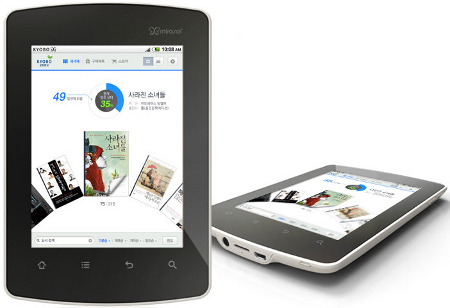
Kyobo e-Reader
(Click to enlarge)
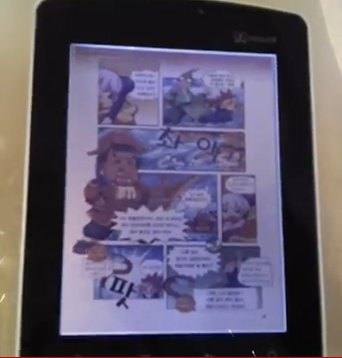
Kyobo e-Reader demonstrated (see video farther below)
 The Kyobo e-Reader began shipping this week in South Korea for the equivalent of $310, says Korean book retail giant Kyobo Book Centre. The tablet offers access to Kyobo's 90,000-title library, which includes books, magazines, and videos.
The Kyobo e-Reader began shipping this week in South Korea for the equivalent of $310, says Korean book retail giant Kyobo Book Centre. The tablet offers access to Kyobo's 90,000-title library, which includes books, magazines, and videos.
The Kyobo e-Reader runs a customized version of Android 2.3 on a 1GHz Qualcomm Snapdragon S2 processor, says Kyobo. The tablet features a 5.7-inch XGA (1024 x 768-pixel) Mirasol display rendering 223 ppi (points per inch) resolution, says the company.
The Kyobo E-reader ships with 512MB of RAM and 2GB of flash memory, and offers a microSD slot capable of handing 32GB cards, says Kyobo. Other features are said to include 802.11b/g/n, a micro-USB 2.0 port, and a 3.5mm audio jack. The device measures 6.85 x 4.69 x 0.51 inches (174 x 119 x 12.9mm) and weighs 11.9 ounces (338 grams), says the company.
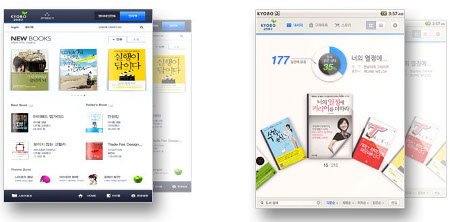
Kyobo e-Reader content and user interface
(Click to enlarge)
Mirasol background
Qualcomm subsidiary Qualcomm MEMS Technologies (QMT) announced its Mirasol color e-reader display technology in 2010, with plans to enter volume production later that year. Meanwhile, market leader E Ink announced a Triton color version of its screens a year ago, but still hasn't shipped them. And Pixel Qi has released some power-saving transflective LCDs, but at a much lower pace than it first predicted.
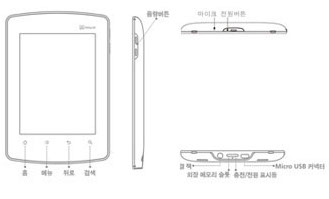
Kyobo e-Reader detail
It seemed as if Qualcomm was going back to the drawing board when, in June, Qualcomm CEO Paul Jacobs was said to have publicly confirmed that the original Mirasol 5.7-inch panel had been abandoned after failing to meet expectations. Instead, the company would devote its attention to the "next version" of the technology, offering brighter colors, said Jacobs.
The Kyobo E-Reader, however, appears to be a variation on this very same 5.7-inch display technology. QMT made no announcements to follow up on Jacobs' plans for a revamped version of the technology.
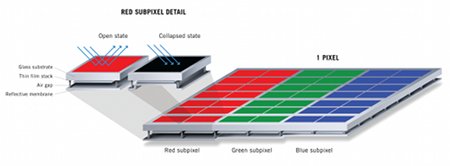
Mirasol technology diagram
(Click to enlarge)
Mirasol's twist is that it uses interferometric modulation (IMOD), the natural manipulation of light found in butterfly wings, sea shells, and peacock feathers. Each IMOD element in a display is built using two conductive plates: One is a thin film stack on a glass substrate, while the other is a reflective membrane.
When no voltage is applied, light hitting the substrate is reflected back, resulting in an element that appears white. When a small voltage is applied, the plates are pulled together by electrostatic attraction and the light is absorbed, turning the element black. At the same time, Qualcomm adds, color can be produced by manipulating voltages so as to vary the size of each gap, reflecting different wavelengths to the viewer's eye.
Kyobo e-Reader demo, apparently from a third party, on YouTube
Source: "truebig230"
(Click to play)
Availability
The Kyobo e-Reader is now available in South Korea for KRW349,000 ($310), discounted to KRW 299,000 ($265) for Kyobo Platinum Book Club members. More information may be found at the Kyobo E-reader product page, as well as at QMT's Mirasol site and this Mirasol page.
This article was originally published on LinuxDevices.com and has been donated to the open source community by QuinStreet Inc. Please visit LinuxToday.com for up-to-date news and articles about Linux and open source.